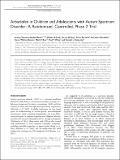Arbaclofen in Children and Adolescents with Autism Spectrum Disorder: A Randomized, Controlled, Phase 2 Trial
Author(s)
Veenstra-VanderWeele, Jeremy; Cook, Edwin H; King, Bryan H; Zarevics, Peter; Cherubini, Maryann; Walton-Bowen, Karen; Bear, Mark; Wang, Paul P; Carpenter, Randall L; ... Show more Show less
DownloadAccepted version (243.0Kb)
Terms of use
Metadata
Show full item recordAbstract
Several lines of emerging data point to an imbalance between neuronal excitation and inhibition in at least a subgroup of individuals with autism spectrum disorder (ASD), including in those with fragile X syndrome (FXS), one of the most common genetic syndromes within ASD. In animal models of FXS and of ASD, GABA-B agonists have improved both brain and behavioral phenotypes, including social behavior. A phase 2 randomized, placebo-controlled, crossover trial found that the GABA-B agonist arbaclofen improved social avoidance symptoms in FXS. A pilot open-label trial of arbaclofen suggested similar benefits in ASD. We therefore evaluated arbaclofen in a randomized, placebo-controlled, phase 2 study of 150 participants, aged 5-21 years, with ASD. No difference from placebo was detected on the primary outcome measure, the parent-rated Aberrant Behavior Checklist Social Withdrawal/Lethargy subscale. However, a specified secondary analysis found improvement on the clinician-rated Clinical Global Impression of Severity. An exploratory post hoc analysis of participants with a consistent rater across the trial revealed greater improvement in the Vineland Adaptive Behavior Scales II socialization domain in participants receiving arbaclofen. Affect lability (11%) and sedation (9%) were the most common adverse events. In this exploratory study, secondary analyses suggest that arbaclofen may have the potential to improve symptoms in some children with ASD, but further study will be needed to replicate and extend these initial findings.
Date issued
2016-10Department
Picower Institute for Learning and MemoryJournal
Neuropsychopharmacology
Publisher
Springer Science and Business Media LLC
Citation
Veenstra-VanderWeele, Jeremy et al. "Arbaclofen in Children and Adolescents with Autism Spectrum Disorder: A Randomized, Controlled, Phase 2 Trial." Neuropsychopharmacology 42, 7 (October 2016): 1390–1398 © 2017 American College of Neuropsychopharmacology
Version: Author's final manuscript
ISSN
0893-133X
1740-634X